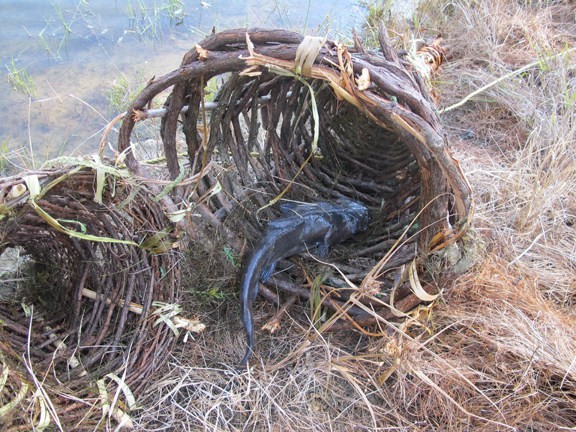The primitive funnel fish trap has been used all over the world for millennia; there are even artifacts of funnel fish traps that have been found in ancient civilizations in the Middle East.
In a survival situation, there is an abundance of raw materials you can use to construct your funnel fish trap; this individual used branches and vines as well as cordage.
It all starts with building the main trap body, which is typically in the shape of large cone. The size is based on the type of fish you’re attempting to catch. I’ve had great success with traps that measure 4-5’ long and the main body opening in the 20-24” range. To build the main body framework you’ll need 7 to 11 small saplings a little longer than your intended main body trap length. The main body must have an odd number of ribs. This is necessary for the over/under weaving pattern that we’ll discuss later. The number you use isn’t important. I normally use 7.
I start by lashing one end of my willow staves around a stick about 12” long x 2” in diameter. This keeps the staves in a nice uniform circle. Then, using a piece of grapevine and some willow bark I create a hoop to form the opening for the main body and quickly tie it to the inside of the other end of the willow staves. This helps to create the main cone shape to the trap body. The hoop will be removed after the trap is about ¼ woven.
Now is time for weaving. I’ve used all kinds of different materials for weaving traps. It really comes down to what is available. In this example I start with some left over willow bark and then move to some cattail leaves. I finish it with a variety of grapevine and Virginia creeper vine. I’ve even used long pieces of grass before.
Once you get about ¼ done with the trap you can pull out the grapevine hoop at the top and the weaving will go much, much faster. The hoop is just to hold the shape temporarily while you get started. You can expect the weaving process to take at least 1-3 hours, depending on the size of the trap. You can extend the length of the trap if you wish by shoving in longer ribs alongside the existing ones and continuing to weave.
When you come to a finishing point, simple lash the last three wraps together in a few spots with some willow bark or cord and trim off the jutting ribs about 1 inch above the rim and the body portion of the trap is finished. It’s now time to weave the cone which will form the cap/entrance of the trap.
The easiest way to form the cone/cap of the trap is to stick an odd number of stakes (ribs) in the ground to form a cone shape. The bottom (smaller hole) of the cone should be large enough for your target fish to fit through. In this case I’ve made mine about 4 inches in diameter. The top should be right around the same diameter of the open mouth of the trap body you’ve just woven. This cone will be a cap for the trap body and you want the two larger holes to mate up nicely.
Once you have the cone shape staked in the ground, it’s time to start weaving again. I prefer smaller vines over larger hard to manage ones. The ones in this example are about ¼ inch in diameter. Weave them to the very top of the cone shape and lash them to finish it off just like the end of the body.
Pull the cone from the ground and trim off any protruding ribs from the top and bottom holes.This concludes all of the hard work. Now, the trap is ready to be baited and set over and over again. This is a self sustaining trap. Each time something is caught, the inedible and unusable parts such as the intestines and some organs and bones are used to bait the trap again to catch more food. I’ve found that native fish parts and pieces produce much better results than store bought items such as chicken livers, bread or peanut butter. All animals prefer to eat what they naturally would.
Fish can be a life saver in a survival situation. Even fish that may not be appetizing in normal times, like carp, possess valuable nutrients and protein that can nourish your body.
One relatively easy way to catch fish is to use a primitive fish trap.
To learn more about how the primitive funnel fish trap works as well as what types of bait to use, check out Willow Haven Outdoor.
Featured Image via Willow Haven Outdoor
